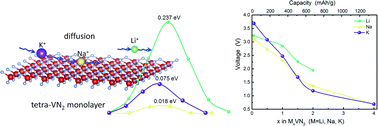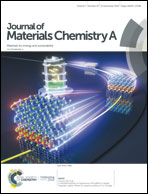Theoretical prediction and atomic-scale investigation of a tetra-VN2 monolayer as a high energy alkali ion storage material for rechargeable batteries†
Abstract
Identifying high performance electrode materials particularly with a large capacity and appropriate working voltage is one of the most promising approaches for improving the energy density of rechargeable batteries. Herein, a tetra-VN2 monolayer with intrinsic thermal/dynamic stability and excellent electronic conductivity is described that was identified using energy and stability directed screening as a potential electrode material for rechargeable alkali ion batteries. The maximum alkali ion storage was found for Li2VN2, Na4VN2 and K4VN2, which corresponded to specific capacities of 679, 1358 and 1358 mA h g−1. The average working voltages of tetra-VN2 in Li-, Na-, and K-ion batteries were 2.59, 1.59, and 1.62 V, which produced specific energies of 1761, 2162, and 2206 W h kg−1, which were much larger than those of most well-known cathode materials. This suggested that the tetra-VN2 monolayer could be a promising alkali ion storage material for high energy rechargeable batteries. Interestingly, different from intercalation-type cathode materials, alkali ions were stored in the tetra-VN2 monolayer via an adsorption/desorption process. With this surface storage mechanism, the alkali ions could migrate in the electrode with low energy barriers, which were found to be 0.237, 0.018, and 0.075 eV for Li+, Na+, and K+, respectively. This feature was representative of the excellent rate capability of tetra-VN2 in rechargeable batteries.



 Please wait while we load your content...
Please wait while we load your content...